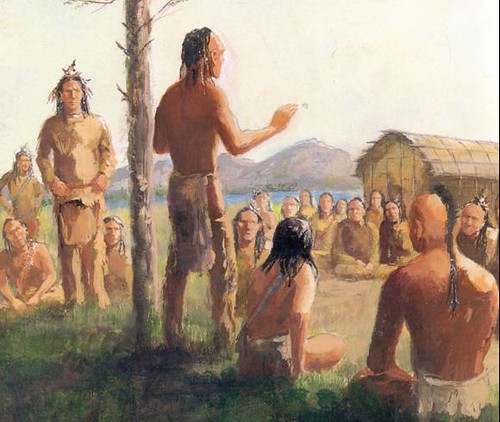Iroquois Confederacy, confederation of five Indian nation across upper New York state that during the 17th and 18th centuries played a strategic role in the struggle between the French and British for mastery of North America. The five original Iroquois nations were the Mohawk (self-name: Kanien’kehá:ka [“People of the Flint”]), Oneida (self-name: Onᐱyoteʔa∙ká [“People of the Standing Stone”]), the confederacy became known to the English as the five Nations and was recognized as such at Albany, New York (1722). Often characterized as one of the world’s oldest participatory democracies, the confederacy has persisted into the 21st century.
The Peacemaker story of Iroquois tradition credits the formation of the confederacy, to Dekanawidah (the Peacemaker), born a Huron, who is said to have persuaded Hiawatha, an Onondaga living among Mohawks, to advance “peace, civil authority, righteousness, and the great law” as sanctions for confederation. Cemented mainly by their desire to stand together against invasion, the tribes united in a common council composed of clan and village sachems; each tribe had one vote, and unanimity was required for decisions. Under the Great Law of Peace Kaianerehkowa, the joint jurisdiction of 50 peace chiefs, known as sachems, embraced all civil affairs at the intertribal level.
The Iroquois (rotinonsonni) Confederacy differed from other American Indian confederacies in the northeastern woodlands primarily in being better organized, more consciously defined, and more effective. The Iroquois used elaborately ritualized systems for choosing leaders and making important decisions. They persuaded colonial governments to use these rituals in their joint negotiations, and they fostered a tradition of political sagacity based on ceremonial sanction rather than on the occasional outstanding individual leader. Because the league lacked administrative control, the nations did not always act in unison, but spectacular successes in warfare compensated for this and were possible because of security at home.
During the formative period of the confederacy about 1600, the Five Nations remained concentrated in what is now central and upper New York state, holding their own with the neighbouring Huron and Mohican (Mahican), who were supplied with guns through their trade with the Dutch. By 1628, however, the Mohawk had emerged from their secluded woodlands to defeat the Mohican and lay the Hudson River valley tribes and New England tribes under tribute for goods and wampum.

The Mohawk traded beaver pelts to the English and Dutch in exchange for firearms, and the resulting depletion of local beaver populations drove the confederacy members to wage war against far-flung tribal enemies in order to procure more supplies of beaver. In the years from 1648 to 1656, the confederacy turned west and dispersed the Huron, Tionontati, Neutral, and Erie tribes. The Andaste succumbed to the confederacy in 1675, and then various eastern Siouan allies of the Andaste were attacked. By the 1750s most of the tribes of the Piedmont had been subdued, incorporated, or destroyed by the league.
The Iroquois also came into conflict with the French in the later 17th century. The French were allies of their enemies, the Algonquins and Hurons, and after the Iroquois had destroyed the Huron confederacy in 1648–50, they launched devastating raids on New France for the next decade and a half. They were then temporarily checked by successive French expeditions against them in 1666 and 1687, but, after the latter attack, led by the marquis de Denonville, the Iroquois once again carried the fight into the heart of French territory, wiping out Lachine, near Montreal, in 1689.